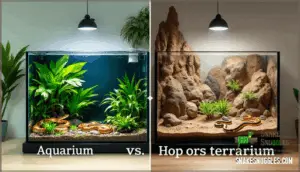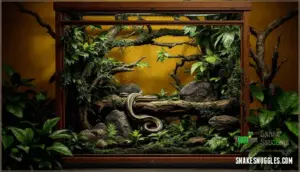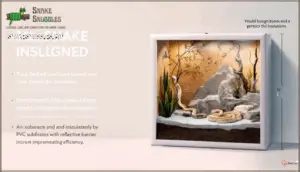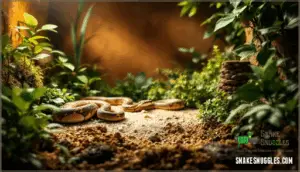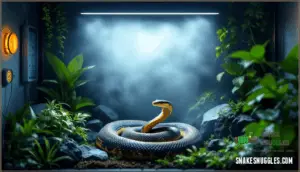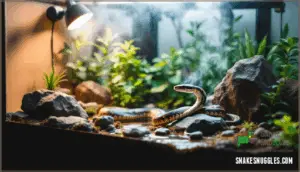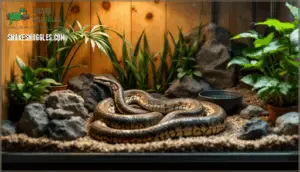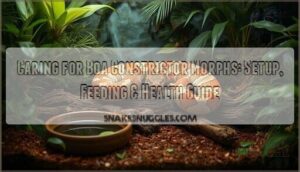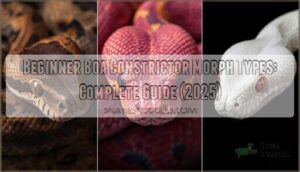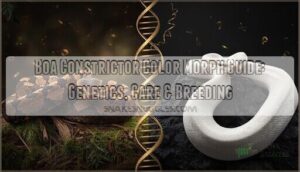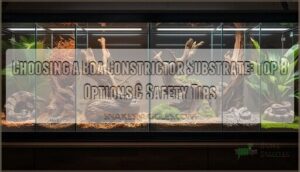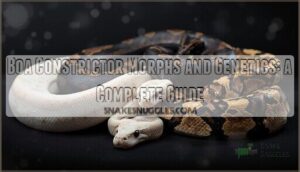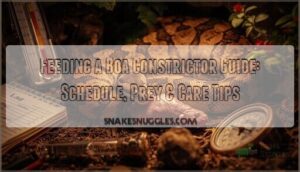This site is supported by our readers. We may earn a commission, at no cost to you, if you purchase through links.
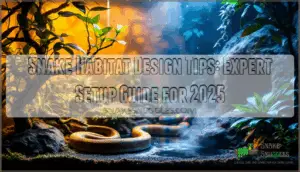
Your corn snake’s thermal preferences differ radically from a rainbow boa’s, yet both suffer when owners prioritize aesthetics over evidence-based environmental parameters.
Proper snake habitat design tips synthesize species-specific ecology with practical monitoring systems, transforming generic tanks into spaces that support natural behaviors while preventing the respiratory infections and feeding refusals that plague poorly configured setups.
Table Of Contents
Key Takeaways
- Snake habitats fail when owners prioritize aesthetics over species-specific environmental parameters like precise temperature gradients, humidity control, and thermoregulation zones—millimeter-level precision in these microclimates determines whether your snake thrives or just survives.
- Enclosure material choices directly impact your snake’s health: PVC offers superior insulation for humidity-sensitive species, while proper substrate selection (coconut husk for tropical, aspen for arid) affects thermoregulation, burrowing behavior, and moisture retention more than any other design element.
- Creating a thermal gradient with a warm zone around 29-32°C and cool side at 24-26°C isn’t optional—snakes can’t regulate their own body temperature internally, so they depend entirely on shuttling between temperature zones for digestion, immune function, and survival.
- Daily monitoring with calibrated instruments catches environmental drift before stress signals appear in your snake, while avoiding toxic materials like cedar substrates, unmonitored heat rocks, and painted décor prevents respiratory damage, burns, and pathogen introduction that plague poorly maintained setups.
Choosing The Right Snake Enclosure
Your first decision—choosing the right enclosure—sets the foundation for everything that follows. The market offers several distinct options, each with trade-offs in ventilation, humidity retention, and ease of maintenance.
Let’s compare the primary enclosure types so you can match your snake’s needs with the right housing solution.
Aquariums Vs. Terrariums
When you’re shopping for your snake’s new home, the choice between an aquarium and a terrarium isn’t just semantics—it’s about matching ventilation, humidity retention, and temperature stability to your specific species’ needs. Glass options dominate the market, but their structural differences matter:
- Aquariums feature top-only ventilation systems, making them ideal for moisture control in tropical species but requiring careful insulation materials to prevent heat loss
- Terrariums offer front and top airflow, benefiting arid-adapted snakes that need lower humidity
- Tank size and vivarium setup should prioritize your snake’s thermoregulatory behaviors over aesthetic reptile habitat design preferences
Cages and Custom Enclosures
Beyond glass tanks, PVC cages, and custom-built enclosures let you fine-tune every parameter—from insulation thickness to access panel placement—making them particularly valuable for species with demanding environmental requirements or for keepers managing multiple animals.
Here’s how different enclosure materials stack up:
| Material | Best For | Key Advantage |
|---|---|---|
| PVC | Ball pythons, humidity-sensitive species | Excellent insulation, lightweight |
| Melamine | Multi-animal facilities | Cost-effective, customizable ventilation systems |
| Wood (sealed) | Large constrictors, naturalistic vivarium design | Excellent heat retention, structural strength |
| Hybrid mesh | Arboreal species | Enhanced airflow for terrarium setup needs |
Custom designs prioritize cage security with locking mechanisms that prevent escapes while maintaining proper snake safety through rounded edges and non-toxic finishes.
Materials and Insulation Options
Your choice of insulation directly impacts temperature gradients and heat retention, making material safety paramount. Foil-backed foam board adds thermal mass to PVC enclosures, while cork panels provide naturalistic insulation with moisture resistance. Reflective barriers beneath substrate improve heating efficiency without compromising humidity levels. Avoid fiberglass or exposed adhesives—both off-gas compounds that stress reptiles during enclosure setup.
When designing a reptile enclosure, consider the importance of proper reptile enclosure materials to guarantee a safe and healthy environment.
Proper Enclosure Size and Design
Once you’ve locked in the right materials and insulation, the enclosure’s physical dimensions and layout become the framework that either sustains or constrains your snake’s long-term health. Match tank size to your snake’s adult length—terrestrial species need floor space, while arboreal ones require vertical habitat depth. Smart enclosure design prioritizes function:
- Space Optimization: Allow a perimeter equal to your snake’s length for natural movement patterns
- Visual Barriers: Incorporate partial dividers to reduce stress and create security zones
- Habitat Depth: Provide substrate depth of 3-4 inches for burrowing behaviors
- Snake Movement: Design linear pathways that encourage exploration without dead ends
- Enclosure Layout: Position hides and thermal zones to promote active thermoregulation
Proper terrarium design respects both spatial and psychological needs—your snake won’t thrive in cramped quarters, no matter how perfect the temperature gradient.
Creating Ideal Temperature and Humidity
Your snake’s health hinges on getting temperature and humidity right—these aren’t optional extras, they’re survival essentials. Snakes can’t regulate their own body temperature, so you’ll need to create a thermal gradient that lets them choose their comfort zone throughout the day.
Temperature and humidity aren’t optional—they’re survival essentials for snakes that can’t regulate their own body heat
Here’s how to dial in the environmental conditions that keep your snake thriving.
Temperature Gradients and Thermoregulation
Your snake can’t regulate its body temperature internally—it relies entirely on external heat sources to manage thermoregulation. Create a thermal gradient by positioning heat sources on one end of the enclosure, establishing a warm zone around 29–32°C and a cooler side near 24–26°C.
This temperature control allows your snake to shuttle between thermal zones, maintaining ideal body temperature for digestion, activity, and immune function. Species like ball pythons and corn snakes depend on gradient management for healthy thermoregulation.
Proper temperature management involves understanding the temperature guide rules to guarantee a safe environment.
Humidity Control Strategies
You’ll maintain ideal humidity levels through strategic layering of moisture control tools. Position humidity sensors mid-enclosure to track readings within ±2% accuracy, then adjust using fogging systems delivering 0.5-1.5 liters daily or manual misting twice per day.
A humid hide lined with moistened sphagnum moss creates an 80-100% microclimate supporting successful ecdysis.
Balance substrate moisture levels with proper ventilation—allowing 10-20 air exchanges hourly prevents mold while sustaining target humidity ranges specific to your species’ thermoregulation and hydroregulation needs.
Backup Heating and Safety Precautions
When your primary heating source fails during a midnight cold snap, a well-planned backup system becomes the difference between a healthy snake and a veterinary emergency. Install secondary heating elements on separate thermostats, and maintain emergency power solutions that preserve temperature gradients for 12-24 hours minimum.
- Battery-powered heat packs wrapped in towels maintaining thermal zone creation
- Propane-safe portable heaters positioned three feet from enclosures
- Thermal monitoring alerts texting you when temperatures drop below safety protocols
- Redundant heating sources preventing exposure to temperature extremes
Selecting Substrates and Decor
The foundation beneath your snake and the features within its enclosure directly influence both health and behavior. Your substrate choice affects humidity retention, cleanliness, and your snake’s comfort, while decorative elements provide security and mental stimulation.
Let’s examine the options that balance natural function with practical maintenance.
Safe and Naturalistic Substrate Choices
Your substrate choice affects thermoregulation, humidity control, and snake behavior more than any other single design element. Safe substrate materials include coconut husk for tropical species, aspen shavings for arid snakes, and cypress mulch for moderate-humidity environments. Avoid cedar, pine, and walnut—these release aromatic oils toxic to reptiles.
Naturalistic designs using multiple substrate layers encourage natural burrowing behaviors while supporting species-specific moisture requirements in your snake habitat.
Hiding Spots and Enrichment Features
Every snake needs a secure retreat where it feels invisible—without this, even well-fed specimens refuse to eat and develop chronic stress responses. Strategic hide box placement on both thermal gradients prevents stress-induced health complications while supporting natural thermoregulation behaviors.
Proper terrarium design and setup prioritizes environmental enrichment for snakes through naturalistic complexity.
Effective enrichment features include:
- Multiple visual barriers positioned throughout your snake habitat to reduce exposure anxiety
- Snake tunnel systems that mimic natural burrow networks and encourage exploration
- Environmental textures like cork bark and slate that provide varied tactile experiences
- Climbing structures integrated with hiding spots for arboreal and semi-arboreal species
Climbing Structures and Environmental Enrichment
Think of arboreal species in the wild—they’re not crawling across flat ground but traversing a three-dimensional maze of branches, vines, and layered canopy structures that shape their entire behavioral repertoire. Proper reptile habitat design incorporates climbing structures and vertical space to support species-specific care and housing needs.
| Enrichment Element | Design Function |
|---|---|
| Branch Placement | Creates horizontal pathways and basking perches at varied heights |
| Rock Features | Provides thermal mass and textured climbing surfaces |
| Texture Variety | Stimulates natural exploration and shedding behaviors |
Strategic terrarium design and setup transforms static environments into active spaces where enrichment toys and structural complexity encourage natural movement patterns.
Lighting, Ventilation, and Water Needs
Getting the environmental basics right goes beyond heat and humidity. Your snake also needs proper lighting rhythms, fresh air circulation, and consistent access to clean water.
Let’s look at how each element contributes to a thriving habitat.
Lighting Cycles and Photoperiod
Properly designed lighting cycles are among the most overlooked factors in snake husbandry, yet they profoundly influence circadian rhythms, melatonin regulation, and immune function. You’ll want to match your snake’s natural photoperiod to support thermoregulation and metabolic health:
- Set timers for 10-14 hours of light depending on species and season—this maintains circadian synchronization and prevents stress-related immune suppression.
- Avoid red or artificial lighting at night, which disrupts melatonin secretion and alters natural behavior patterns.
- Use full-spectrum or UVB lighting for diurnal species to replicate natural light cycles and support physiological processes like temperature regulation.
Ventilation for Health and Comfort
While light sets your snake’s internal clock, adequate airflow keeps respiratory systems functioning and prevents the buildup of pathogens that thrive in stagnant, humid microclimates.
You’ll need proper ventilation that balances fresh air flow with humidity control—screen tops work for arid species, while strategic vents in plastic enclosures maintain humidity levels without sacrificing air exchange.
Breathable materials and ventilation systems support thermoregulation by distributing temperature gradients evenly throughout the enclosure.
Water Features and Hydration Essentials
Just as clean air bolsters respiratory health, access to fresh water maintains hydration and enables essential physiological processes like shedding and waste elimination.
You’ll want a sturdy water dish that won’t tip, placed on the cooler side to prevent excessive evaporation that disrupts humidity levels.
Regular water source maintenance—changing it daily—guarantees water quality while your bowl placement strategy directly influences both hydration patterns and humidity control throughout the enclosure.
Maintenance Tips and Common Mistakes
Even the best habitat falls apart without consistent care, and small oversights can snowball into serious health problems. Knowing what to watch for and how to stay ahead of issues makes all the difference between a thriving snake and a struggling one.
Let’s walk through the practical steps that keep your setup safe and your snake healthy.
Cleaning Routines and Disease Prevention
Your maintenance routine shouldn’t just look clean—it needs to eliminate pathogens that threaten reptile health and wellness. Daily cleaning involves removing feces and urates immediately, washing water bowls with hot soapy water, and using dedicated tools stored separately.
Monthly deep cleaning with proper disinfectant use, like F10SC diluted 1:250, targets bacteria and viruses. Quarantine protocols with separate equipment slash disease transmission rates below 5%.
Strong biosecurity measures and pathogen control protect your snake from the 30% Salmonella prevalence documented in captive collections.
Monitoring Conditions and Troubleshooting
Consistent monitoring with calibrated instruments catches environmental drift before your snake shows stress signals—thermal gradients shift, humidity creeps out of range, and equipment failures happen without warning.
Digital thermometers with temperature alarms and hygrometers with environmental alerts let you track condition checks remotely. When temperature extremes occur, you’ll spot compromised thermoregulation before it impacts snake health.
Weekly calibration against reference instruments keeps your humidity controls accurate within 5%.
Avoiding Toxic Materials and Setup Errors
Cedar shavings, unregulated heat rocks, and untreated wood décor can leach toxins or cause burns—your snake’s health hinges on recognizing hazardous materials before they enter the enclosure.
Avoid these common setup mistakes and toxic materials:
- Aromatic substrates like pine or cedar release volatile oils that damage respiratory systems
- Unmonitored heat rocks create temperature extremes leading to thermal burns
- Painted or varnished décor leaches chemicals into humid environments
- Improper quarantine procedures introduce parasites and pathogens to safe enclosures
- Loose screen tops on glass tanks allow escapes and compromise secure enclosure design
Error prevention starts with substrate choices for snakes that prioritize safety over aesthetics—hazard avoidance protects your investment in proper husbandry.
Frequently Asked Questions (FAQs)
How often should I handle my snake?
Interaction frequency depends on the species and individual temperament. Start with brief 5-10 minute sessions two to three times weekly, gradually increasing as your snake adjusts.
Watch for stress signals—defensive posturing or excessive movement—and adjust accordingly.
Can multiple snakes share one enclosure safely?
Most snake species shouldn’t cohabit due to risks including stress, competition, disease transmission, and cannibalism. Snake socialization differs from mammals—these solitary animals don’t benefit from companionship.
Even with adequate enclosure size and species-specific care matching animal behavior and psychology, multi-species or same-species housing often ends badly.
What signs indicate my snake is stressed?
Stress signals include refusal to eat, excessive hiding, defensive posturing, frequent striking, unusual lethargy, or constant pacing.
Environmental factors—wrong temperatures, humidity issues, or inadequate hiding spots—commonly trigger these stress responses, requiring immediate habitat adjustments.
How do I transition my snake between enclosures?
Think of it like moving into a new apartment—you don’t want to rush the process. Transfer your snake using a secure container, match temperature and humidity exactly between enclosures, and allow 48-72 hours for snake acclimation without touching to minimize snake stress during habitat shift.
Should I use live or artificial plants?
Both options work well for species-specific care and housing, but they serve different purposes. Artificial plants offer easy fauna and flora management—no maintenance, waterproof, and safe if you choose reptile-specific products.
Live plants boost environmental enrichment for reptiles through natural humidity regulation and a truly naturalistic environment, though they require proper terrarium and vivarium setup.
Conclusion
Your vivarium is a canvas, but the brushstrokes must follow biology—not Instagram trends. Every snake habitat design tip in this guide circles back to one truth: precision in microclimates drives welfare outcomes.
When you calibrate gradients within 2°F tolerances, monitor humidity cycles twice daily, and choose substrates that mirror native soil composition, you’re not decorating—you’re engineering survival.
The glass walls contain more than a reptile; they hold your responsibility to replicate what millions of years perfected. Get the details right, and thriving becomes inevitable.

